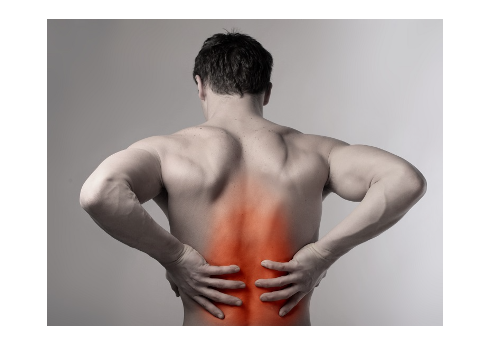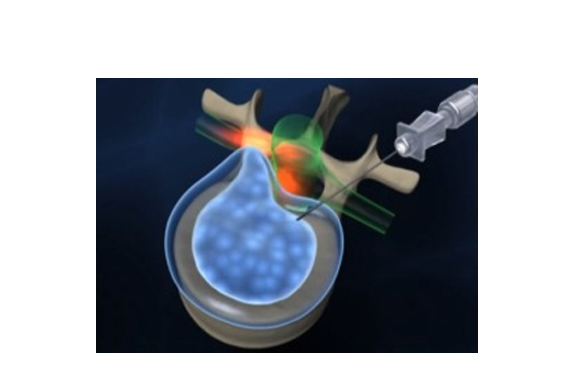By: Geraldus Sigap
Back pain is a common issue that affects millions of people worldwide, often making everyday tasks difficult and reducing quality of life. For many, the cause of this pain is a herniated or bulging disc, a condition where the soft material inside the spinal disc pushes through its outer layer. This pressure on nearby nerves can cause severe pain, numbness, and mobility problems. Traditional treatments for herniated discs have included surgery or long-term medication use, but there is a minimally invasive alternative that is gaining popularity: Percutaneous Laser Disc Decompression (PLDD) therapy.

Figure 1. Backpain
Percutaneous Laser Disc Decompression, or PLDD, is a minimally invasive procedure designed to treat herniated discs. In simple terms, it uses laser energy to reduce the pressure within the affected disc, relieving pain and restoring function. The procedure involves inserting a thin needle into the herniated disc, guided by imaging technology. A laser fiber is then inserted through the needle, delivering precise energy to vaporize a small portion of the disc’s material. This reduces the size of the herniation, relieving pressure on the nerves and providing pain relief.
PLDD offers several advantages over traditional surgery and other treatments for back pain. One of its main benefits is that it is minimally invasive. Unlike open surgery, which requires large incisions and significant tissue disruption, PLDD is performed through a small puncture, minimizing trauma to the surrounding tissues. This approach results in less pain, faster recovery, and minimal scarring.
Another key advantage of PLDD is its high success rate. Studies have shown that PLDD effectively reduces pain and improves mobility for a large percentage of patients. Because the procedure targets the specific area causing the problem, it provides targeted relief, unlike generalized treatments like medications that may not address the root cause of the pain.
PLDD is typically performed under local anesthesia, meaning the patient remains awake but comfortable throughout the procedure. The process begins with the doctor using imaging technology, such as X-rays or CT scans, to precisely locate the herniated disc. Once the disc is identified, a small puncture is made, and a thin needle is inserted into the disc.
The doctor then inserts a laser fiber through the needle. The laser energy heats and vaporizes a small portion of the disc’s nucleus (the soft, inner part), reducing its volume. This process reduces the pressure inside the disc, allowing it to retract and relieve the pressure on the surrounding nerves. The entire procedure usually takes less than an hour, and the patient can typically go home the same day.
One of the most appealing aspects of PLDD is the quick recovery time. Because the procedure is minimally invasive, most patients can resume light activities within a few days and return to their normal routines within a few weeks. There is no need for a lengthy hospital stay, and patients experience less discomfort compared to traditional surgical methods.

Figure 2. PLDD Procedure
Many patients report a significant reduction in pain shortly after the procedure. The benefits of PLDD can be long-lasting, as reducing the pressure within the disc helps prevent further degeneration and inflammation. However, like any medical procedure, individual results may vary. Some patients may require follow-up treatments or physical therapy to achieve the best outcome.
While surgery may still be necessary for severe cases of herniated discs, PLDD offers an effective alternative for many patients. Here are some reasons why PLDD is becoming a preferred choice:
- Less Invasive: Traditional disc surgery, such as discectomy or spinal fusion, involves large incisions and a significant recovery period. PLDD, on the other hand, requires only a small puncture, meaning less pain and a quicker recovery.
- Faster Recovery: With PLDD, most patients can return home the same day and resume their normal activities much sooner than with traditional surgery. This is particularly beneficial for those who cannot afford extended downtime due to work or family responsibilities.
- Minimal Scarring and Risk: Since PLDD does not involve large cuts, scarring is minimal, and the risk of infection is significantly reduced. This makes PLDD a safer option for those who may have concerns about surgical complications.
- Effective Pain Relief: PLDD directly targets the source of the problem, providing effective and long-lasting relief for many patients. By reducing the pressure on the nerves, it helps alleviate symptoms such as back pain, numbness, and leg weakness.
- Outpatient Procedure: PLDD is typically performed on an outpatient basis, which means no overnight hospital stays are required. This convenience is appealing to many patients, as it allows them to recover in the comfort of their own homes.
Before undergoing PLDD therapy, patients must go through a thorough evaluation to ensure they are suitable candidates for the procedure. One of the essential steps in preparing for PLDD is undergoing an MRI (Magnetic Resonance Imaging) of the spine. The MRI scan provides detailed images of the spinal discs and surrounding structures, helping the doctor precisely identify the location and extent of the herniation. This imaging is crucial for planning the procedure, as it allows the orthopedic specialist to determine the exact target area for the laser treatment. Additionally, patients may be required to stop taking certain medications, especially blood thinners, before the procedure to reduce the risk of bleeding. It is also important for patients to inform their doctor about any allergies, especially to medications or anesthesia. On the day of the procedure, patients are typically advised to fast for a few hours to prepare for the local anesthesia. A comprehensive medical evaluation, including these steps, helps ensure the safety and effectiveness of the PLDD treatment.
PLDD is suitable for individuals who have been diagnosed with a herniated or bulging disc and have not responded well to other treatments, such as physical therapy or medications. It is an ideal option for those seeking a minimally invasive approach to relieve pain without the risks and long recovery associated with traditional surgery.
However, not every patient is a candidate for PLDD. A thorough evaluation by an orthopedic specialist is necessary to determine if this procedure is the best option for your specific condition. Factors such as the size and location of the herniation, the patient’s overall health, and the severity of symptoms all play a role in deciding the appropriate treatment.
RS Abdi Waluyo committed to providing the highest level of orthopedic care. Our experienced team of specialists is trained in advanced techniques like PLDD, ensuring that each patient receives personalized, effective treatment tailored to their needs. If you are experiencing back pain or have been diagnosed with a herniated disc, our team is here to guide you through your treatment options and help you make an informed decision.
Resources
- Middle Back Pain | Scottsdale, AZ Orthopedic Spine Surgery [Homepage on the Internet]. Microspine PLC. [cited 2024 Oct 23];Available from: https://www.microspinemd.com/conditions-treated/middle-back-pain/
- What is the PLDD technique of disk hernias treatment [Homepage on the Internet]. [cited 2024 Oct 23];Available from: https://www.spine-pldd.com/?way=pagine&IDCAT=TRATTAMENTO&IDSCAT=LASERSURGERY
- Brouwer P, Brand R, Van den Akker E, et al. Percutaneous laser disc decompression (PLDD) versus conventional microdiscectomy in sciatica: a randomized controlled trial. Spine J 2015;15.
- Brouwer PA, Peul WC, Brand R, et al. Effectiveness of percutaneous laser disc decompression versus conventional open discectomy in the treatment of lumbar disc herniation; design of a prospective randomized controlled trial. BMC Musculoskelet Disord 2009;10:49.
